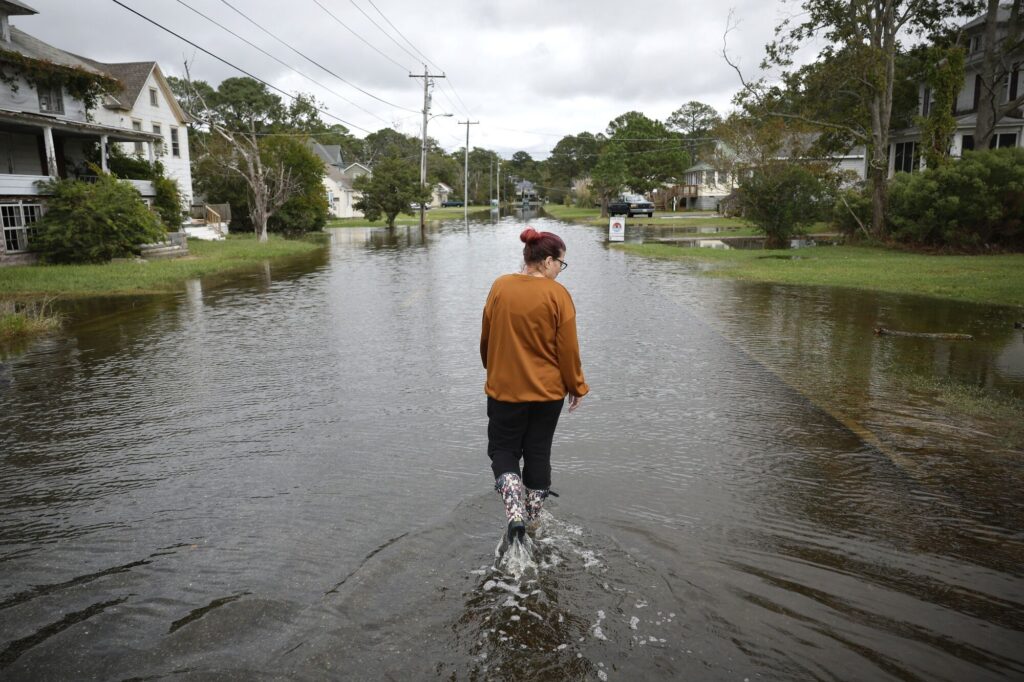Originally published in Bloomberg CityLab, December 2023.

In Oyster, Virginia, an unincorporated community that clings to an eroding spit of low-lying land on the state’s Eastern Shore, inundation has become part of daily life. Since the 1920s, sea levels here have risen by a foot and a half, and high-tide flooding is now common.
Donna Fauber, who has lived in Oyster for 20 years, has gotten in the habit of moving her car to a lot that sits on higher ground when flooding looks likely. She and her neighbors share weather updates in a group text. “We’ll say, ‘Tide’s up, move your cars,’” she says.
The rising waters are claiming landmarks like a historic cemetery and threatening Oyster’s fishing industry, occasionally making the roads that residents use to get to their homes impassable. “They’re living with the threat of flooding all the time,” says Jill Bieri, the director of the Nature Conservancy’s Volgenau Virginia Coast Reserve, a complex of 40,000 acres of barrier islands, marshland and other coastal ecosystems that helps protect Shore settlements from storm surges.
The Nature Conservancy manages 2,000 acres of land in and around Oyster, and the environmental nonprofit recently began assisting the town’s residents with the development of a community climate adaptation plan. Hovering around the edges of the effort — though often unspoken — is an emotionally and logistically difficult question: Stay or go?
In the face of more frequent and severe weather events, many hundreds of communities in the US could soon be facing the same heart-wrenching choice. Even under optimistic scenarios, scientists predict that by 2100 some 4.2 million Americans across 500 coastal communities will experience “disruptive inundation.” By 2050, the Congressional Budget Office estimates that the annual cost of flood damage to homes with federally backed mortgages is expected to reach $12.8 billion, a jump of 30% from today’s $9.4 billion.
And yet, as evidenced by the unusual role the Nature Conservancy is playing in Virginia, existing federal disaster preparedness and response programs are patchy and poorly coordinated, often prioritizing short-term fixes for affluent property owners and disadvantaging tiny towns like Oyster.
“The first thing that small communities up and down the East Coast will say to you is, ‘We’re not on the radar screen of state and federal agencies. No one’s gonna buy us out. No one’s gonna help us,’” Bieri says.
The mismatch between the risks communities face and the design of government programs has led some experts to consider whether an entirely new federal entity is needed — a department that could plan and coordinate the challenging process of relocation and adaptation known as managed retreat.
Currently, property buyout programs at the federal, state and local level can be divorced from large-scale infrastructure investments, as well as post-buyout land or environmental planning, which limits their ability to address the complex web of social, ecological and economic factors that will ultimately shape a community’s ability to absorb climate shocks.
“There’s no thread that connects the investment [of a buyout] to something that is actually meaningful. There’s nothing that follows the dot all the way through,” says Kate Orff, faculty director of Columbia University’s Center for Resilient Cities and Landscapes and the recipient of a MacArthur “genius grant” for her work on coastal adaptation. What’s needed “is a program that actually looks more synthetically at how all of these things come together.”
Read the rest of the article in Bloomberg CityLab.